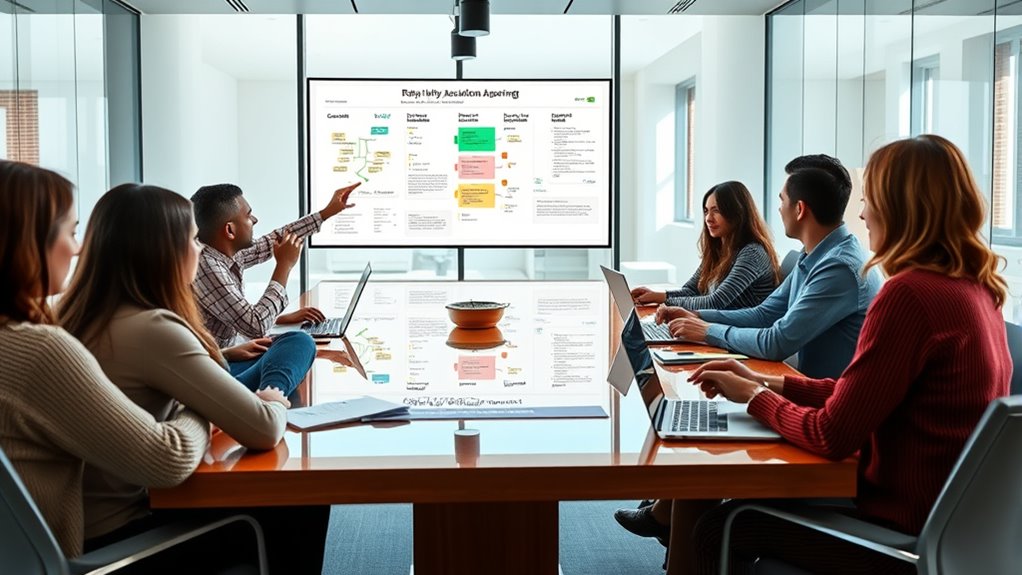Involving quality assurance early in requirements gathering helps identify gaps, ambiguities, and inconsistencies before they become costly errors. By collaborating with QA from the start, you guarantee requirements are clear, feasible, and aligned with project goals. This proactive approach fosters better stakeholder communication, reduces misunderstandings, and streamlines validation. If you keep exploring, you’ll discover how continuous stakeholder engagement and thorough documentation further strengthen your requirements process.
Key Takeaways
- Integrate validation early to identify errors and ambiguities before requirements are finalized.
- Engage stakeholders throughout the process to ensure requirements are accurate and aligned with business needs.
- Use iterative review sessions and workshops to verify requirements’ completeness and feasibility early on.
- Maintain transparent documentation of stakeholder inputs and validation decisions for traceability.
- Foster continuous communication to address conflicting interests and refine requirements proactively.

How can you guarantee that the requirements you gather are accurate and complete? The answer lies in engaging stakeholders early and often through effective stakeholder communication. When you involve the right people from the start, you gain diverse perspectives that help uncover hidden needs and clarify expectations. This proactive approach reduces misunderstandings and ensures everyone is aligned on project goals. Consistent stakeholder communication also fosters trust, making it easier to address concerns and adapt requirements as needed. Remember, requirements validation isn’t a one-time activity; it’s an ongoing process that confirms your understanding matches stakeholder intentions.
Integrating requirement validation early in the process is vital. Instead of waiting until the requirements are documented and finalized, you should continuously validate them with stakeholders. This means reviewing drafts together, asking targeted questions, and verifying that the documented needs truly reflect what stakeholders want. When you validate requirements early, you catch errors and ambiguities before they cascade into costly issues during development. This iterative validation helps you refine and prioritize requirements, ensuring they are both feasible and aligned with business objectives.
To maximize the effectiveness of requirement validation, adopt a collaborative approach. Use workshops, interviews, and review sessions to gather feedback. During these interactions, focus on clarifying requirements and confirming their completeness. Ask stakeholders to prioritize needs, identify potential gaps, and highlight any conflicting interests. This not only improves the quality of your requirements but also strengthens stakeholder communication because it demonstrates your commitment to understanding their true needs.
Another key to successful early QA in requirements gathering is maintaining documentation that is accessible and transparent. Keep track of all stakeholder inputs, validation sessions, and agreed-upon changes. This record-keeping helps prevent miscommunication and provides a clear trail of decision-making. When everyone involved can review the documented requirements, it becomes easier to spot inconsistencies and validate that the requirements are accurate and complete. Additionally, understanding the role of the Sun in energy generation and climate regulation can provide useful context for aligning requirements with environmental sustainability goals.
Finally, don’t underestimate the importance of continuous stakeholder engagement. Regular updates and feedback loops keep stakeholders involved and invested in the process. When stakeholders see their input being incorporated and validated, they’re more likely to support the project and help identify potential issues early. This collaborative mindset, combined with ongoing requirement validation, ensures that your requirements are robust, accurate, and ready to guide successful project delivery. By prioritizing stakeholder communication and validation from the outset, you set a solid foundation for quality assurance throughout the requirements gathering phase.
Frequently Asked Questions
How Early Should QA Be Involved in Requirements Gathering?
You should involve QA as early as possible in requirements gathering, ideally during initial stakeholder communication. This allows QA to participate in requirements validation, ensuring clarity and completeness from the start. Early involvement helps identify potential issues, reduce rework, and align expectations. By engaging QA early, you promote better collaboration, improve requirements quality, and streamline the project’s overall development process.
What Tools Facilitate Early QA Involvement in Requirements?
Think of requirements validation like building a house—you want the foundation solid before walls go up. Tools like JIRA, Confluence, and requirements management software enable early QA involvement by facilitating stakeholder collaboration and tracking changes. These tools let you review, comment, and verify requirements early, catching issues before development starts. This proactive approach minimizes rework, ensures clarity, and aligns everyone’s expectations from the beginning.
How Does Early QA Involvement Impact Project Timelines?
Early QA involvement helps you identify issues sooner, which considerably reduces project delays. By actively engaging early, you improve stakeholder collaboration, ensuring requirements are clear and feasible. This approach enables you to mitigate risks effectively, preventing costly rework later. As a result, your project stays on track, deadlines are met, and you deliver a higher quality product, all while minimizing the impact of unforeseen problems on your project timeline.
What Are Common Challenges in Integrating QA Early?
You might find integrating QA early feels like herding cats, but it’s essential for success. The biggest challenges include ensuring stakeholder collaboration and achieving requirement clarity early on. Miscommunication or vague requirements can cause delays and rework. To overcome these, keep communication open, involve QA from the start, and clarify requirements thoroughly. This proactive approach minimizes misunderstandings and helps your project stay on track.
How Can Teams Measure the Success of Early QA Efforts?
You can measure early QA success through improved stakeholder communication and requirement clarity. Track how quickly issues are identified and resolved, which indicates effective collaboration. Gather feedback from stakeholders on their understanding of requirements and whether early QA insights helped prevent misunderstandings. Additionally, monitor changes in defect rates and rework frequency. These metrics show if early QA involvement enhances project quality and aligns expectations, confirming your efforts are effective.
Conclusion
Involving QA early in requirements gathering can boost project success rates by up to 30%. By catching issues early, you save time, reduce costs, and improve overall quality. Remember, your active participation guarantees clearer requirements and fewer misunderstandings down the line. Don’t wait until testing—embed QA in your process from the start. Embrace early QA involvement, and you’ll turn potential pitfalls into opportunities for excellence and efficiency.








